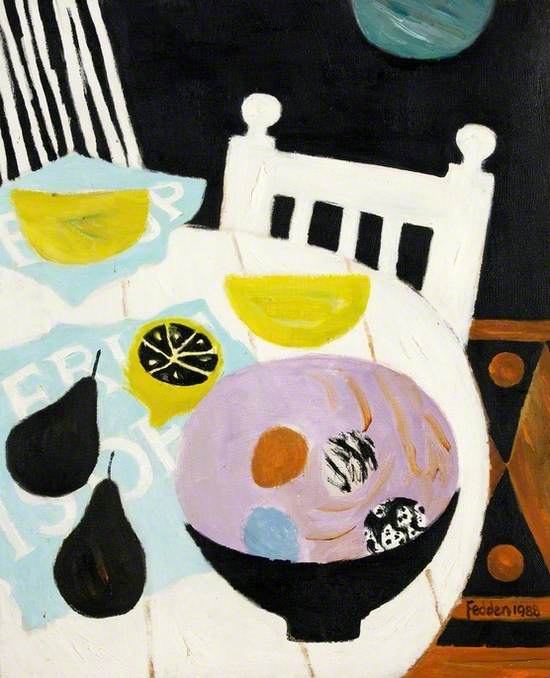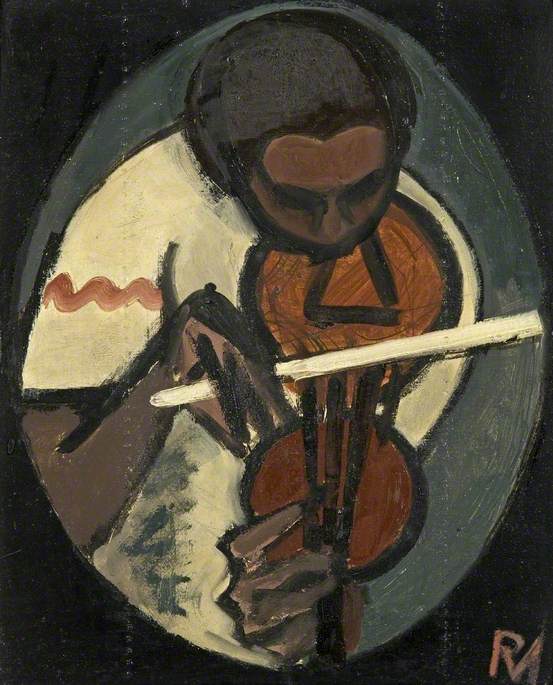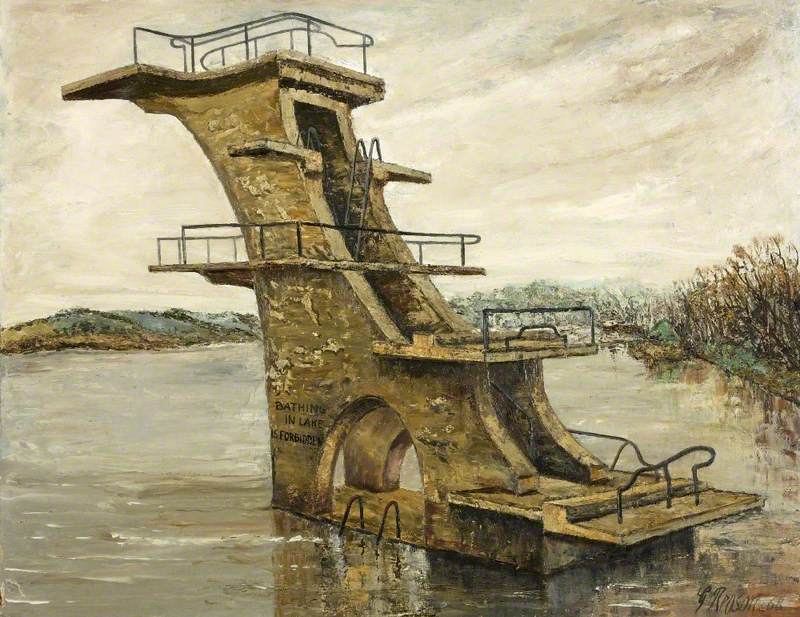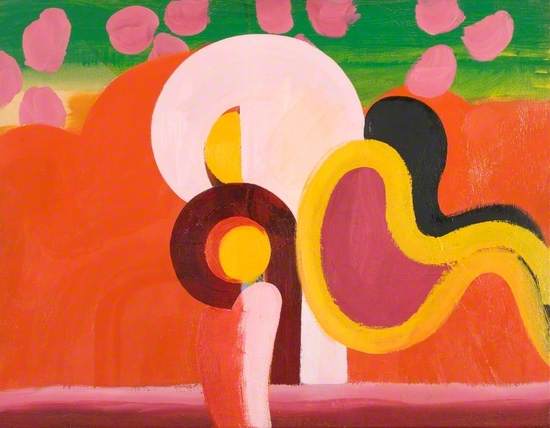In 1871 the Great Western Railway Hospital in Swindon welcomed their first patient. 150 years later in 2020 and 2021, STEAM Museum welcomed doctors, nurses, other healthcare workers and volunteers vaccinating patients against COVID19.
To help them relax during their breaks, the Swindon Art on Tour Team have curated a display of artworks selected from the collections at Swindon Museum and Art Gallery.The artworks explore health and wellbeing through themes including creativity, nature and exercise.
Thanks to Art UK’s Curation tool, we are also able to make a digital version of the exhibition available. For more digital outreach from Swindon Museum and Art Gallery, please visit www.swindonmuseumandartgallery.org.uk/artontour.
A Healthy Diet
An apple a day keeps the doctor away…
Lawrence Gowing’s painting shines a new light on this familiar fruit, inspiring renewed appreciation for its shiny surface and juicy roundness. Apples II is one of fourteen paintings in a series depicting cooking apples on a table. In each piece, their presence is altered by positioning, lighting and other objects in the scene.
Gowing was a member of the Euston Road School, which placed importance on observation as the key to making good art. Apples II presents a close study of the many shades of green present in the apples, which result from sharp tonal contrasts between light and dark. Gowing has rendered this with thick dabs of paint, capturing the crispness of the surface.
Lawrence Gowing (1918–1991)
Oil on board
H 18 x W 28 cm
Swindon Museum and Art Gallery
.

A Healthy Diet
The Spanish Chair depicts pears, a lemon and a fruit bowl on a round table. The painting alludes the traditional subject matter of a still life, but Fedden subtly suggests a human presence too. Unidentified slices of fruit (possibly melon) suggest someone is about to sit down and eat, and the table is tilted toward the viewer, as though we too are invited to dine.
Fedden painted the scene with a characteristically fresh and modern approach, utilising a limited colour palette of pink, yellow, blue and brown, and reducing the objects to simple, flattened forms and essential details. The result is a harmonious pattern with great presence, which is enhanced by areas of deep black and bright white.
Mary Fedden (1915–2012)
Oil on canvas
H 60 x W 49 cm
Swindon Museum and Art Gallery
Fresh Air
Exploring your local landscapes is a great way to get plenty of fresh air, but navigating the unpredictable British weather can be challenging!
In this striking painting, Edward J Buttar captures the effects of changing weather on a natural landscape. A large portion of the painting is dominated by grey clouds that are lined with luminous white. Meanwhile the lush green grass below is enjoying some sunshine, but the turmoil of the trees implies a less than tranquil walk for the woman in the bottom right hand corner. She is wearing a light shawl or cardigan, but the umbrella suggests she has come prepared for a sudden downpour.
The landscape depicted is in Cricklade, not far from Swindon, where Buttar may have lived at the time.
Edward James Buttar (1873–1943)
Oil on canvas
H 62 x W 75 cm
Swindon Museum and Art Gallery
Fresh Air
Christopher Nevinson’s Welsh Hills captures the beauty of the Welsh landscape, through rich planes of colour and a dramatic sense of shifting light. The eye is lead across fields of brown, yellow, green and blue, toward the soft grey hills in the distance. Rays of light emit from a heavy dark cloud in the top right, illuminating the ground below.
Nevinson is best known as a prominent War Artist who recorded the atrocities of WWI, and a futurist whose style was defined by sharp angles and strong lines. After the war, he explored new subject matter and approaches. He drove around the countryside in a car with a caravan attached looking for landscapes to paint, and he visited wales in 1926.
Christopher Richard Wynne Nevinson (1889–1946)
Oil on canvas
H 49.3 x W 59.5 cm
Swindon Museum and Art Gallery
Exercise
We all know that exercise can do us a world of good, whether it’s a walk around the block, a visit to the gym, or a competitive game…
Brazilian modernist Vicente Do Rego Monteiro created a large body of work during his lifetime, and his paintings of sports from the 1920s are among his most celebrated. This piece depicts two Tennis players wearing the distinct white attire associated with the sport. The man in the background is poised and ready for action, whilst the woman in the centre foreground is leaping into the air, with her racket stretched above her head. Monteiro has focused on her freedom of movement, made possible by the shorter skirts available to female tennis players for the first time.
Vicente do Rego Monteiro (1899–1970)
Oil on canvas
H 99 x W 80 cm
Swindon Museum and Art Gallery
Nature
Kate Tryon was an American-born artist, journalist and lecturer on birds and nature. Such work led her to the famous nature writer Richard Jefferies, who was based in Swindon’s Coate Water Country Park.
This painting was probably made during Tryon’s first visit to Swindon in 1910. It depicts the vibrant flower gardens at Burderop Park, and demonstrates her talent for capturing the lush colours of the flowers with quick, impressionistic dabs of paint.
Tryon visited Swindon another five times after this initial trip, and produced over 300 paintings and sketches inspired by the town and surrounding countryside.
Kate Allen Tryon (1865–1952)
Oil on canvas
H 33.5 x W 38.5 cm
Swindon Museum and Art Gallery
.

Nature
This vibrant painting depicts a view of the Thames from Mary Fedden’s home in Durham Warf. We are invited to observe the scene as she does, peering over the garden wall and looking upstream to Chiswick Eyot. In her characteristically direct and naïve approach, Fedden captured boats sailing on the river and the Cow Parsley that sprouted every June.
The scene is infused with freshness and energy, and has been painted with the air of someone happy and familiar with her surroundings. Most of us don’t live in a house overlooking the Thames, but Fedden shows us that even when we have nowhere to go, we can still appreciate the nature that surrounds us!
Mary Fedden (1915–2012)
Oil on canvas
H 49.3 x W 59.5 cm
Swindon Museum and Art Gallery
Music
When the mood is low, we can always rely on music to lift the spirits, or help us understand the way we are feeling.
In the 1945, the celebrated French classical violinist Ginette Neveu wowed more than a few spectators at her concert at Birmingham Town Hall. Among the many admiring listeners was Raymond Mason, who painted this charming image of Neveu in action.
He depicts a performer comfortable in the spotlight, engrossed in her music, and at one with her violin. Neveu’s rounded shoulder echoes the rounded shape of her instrument, and her confident, angular hands echo its black, thickly painted strings.
Raymond Mason (1922–2010)
Oil on canvas
H 39 x W 31.5 cm
Swindon Museum and Art Gallery
Music
Howard Hodgkin’s paintings are often associated with his memories of people and places, and seek to convey a feeling for a moment in time. Gramophone began as a painting of two friends listening to music, but the final piece represents Hodgkin’s memory of the scene, which was transformed over the course of two years. The vibrant yellows, pinks, reds, oranges and greens imply a cheerful atmosphere, and the organic forms feel light, relaxing and musical.
In these difficult times, Gramophone is a reminder that creativity of all forms can be very healing - whether you're making music or listening to it, creating a painting or apprenticing one.
Howard Hodgkin (1932–2017)
Oil on canvas
H 71.5 x W 91.5 cm
Swindon Museum and Art Gallery
.
Music
In 'Sounds and Silences', Jack Smith has given visual form to the experience of sound. He makes use of bright colours, angular segmented compositions and small shapes and symbols to capture different ranges of noise. Perhaps the clear triangles represent silence, and those filled with shapes and colour show loud, vibrant sounds.
Jack Smith (1928–2011)
Oil on canvas
H 104.8 x W 104.8 cm
Swindon Museum and Art Gallery
Creativity
Ivon Hitchens’ Spring in Eden was painted in the artist’s Hampstead studio in the spring of 1925, and can be seen to embody the vibrancy and optimism of being in a creative space.
Hitchens depicted a large still life, with a mirror, flowers, a bowl of fruit, and a cast of a sculpture by Alphonse Legros. The background is defined by the corner of a large canvas, which was intended as a mural of the Garden of Paradise in the Church of St Luke, Maidstone. In the case of this busy painting with its undefined sense of space, the canvas provides the effect of a more open room, which leads to an exterior world.
Ivon Hitchens (1893–1979)
Oil on canvas
H 49 x W 59.5 cm
Swindon Museum and Art Gallery
Creativity
Helen Lessore’s painting depicts a tranquil and somewhat meditative space, bathed in light from an unseen window. According to her son, the painter John Lessore, the space depicted was her drawing room in their Camberwell home. The artist recorded how she was struck by the light flooding into the scene one morning, which transformed it into a new entity.
So the true subject of the painting is the formal appearance of the room at this particular time of day, but the objects can be seen to celebrate the creativity that ran through the Lessore family. The sculptures are by her late husband, Frederick Lessore, and the paintings (including the snow scene on the easel) are by John.
Local Exploration
For many of us, enduring lockdown over the past year has inspired a new appreciation for that which lies right under our noses! This local scene depicts the diving board in Swindon’s Coate Water Country Park.
The board was designed in 1930 by local architect JBL Thompson, and was a great artistic and technical achievement for the time. Though it was intended for the leisure of the people of Swindon, it was closed in 1958 when the lake became polluted.
Reason painted this work around ten years later, when the memory of the diving board as a leisure facility was still very much alive. Now we can appreciate it as a unique and historic Swindon landmark, which sitting majestically on the surface of the water.
George Reason (1901–1984)
Oil on board
H 51.8 x W 67.5 cm
Swindon Museum and Art Gallery
Local Exploration
This painting depicts a wooded area of Coate Water Country Park in Swindon. Though we do not know when it was painted, the palette of vibrant greens and blue sky reflected in the water below suggest a clear, sunny day. However, some of the trees are bare, whilst others are painted in rusty browns, giving the scene an autumnal edge. The artist has used quick, thick strokes of paint to capture the changing landscape, which suggest it may have been painted outdoors.
F. W. Salvage (active 1974)
Oil on canvas
H 28.5 x W 40.5 cm
Swindon Museum and Art Gallery
Rest and Relaxation
Ivon Hitchens’ work hovers between abstraction and figuration. Flattened forms, bold colour and loose brushwork suggest the essence of a scene, rather than a direct imitation.
The Chinese Bowl embodies a relaxed and comfortable atmosphere. A reclining figure is depicted with fluid brushstrokes of fleshy pink paint, whilst the bowed head and open book are suggested with just a few strokes of brown and yellow. The indistinct golden yellow background could be a curtain or wallpaper, whilst a still life in the foreground refers to the Chinese bowl of the work’s title.
Ivon Hitchens (1893–1979)
Oil on canvas
H 59.5 x W 77 cm
Swindon Museum and Art Gallery
.
Rest and Relaxation
Nude with Poppies depicts a nude figure laying on a bed of light blue, against a background of soothing green waves. The two large poppies are positioned above her are symbols of sleep, and can be attributed to the painting’s original purpose as a headboard design. It is a perfect visualisation of rest and relaxation.
Vanessa Bell was a key member of the Bloomsbury Group, a cohort of progressive intellectuals and artists who worked together in the early 20th Century. Bell advocated a modern approach to painting, placing emphasis on lyrical lines, simplified form and bold colours. She also sought to break down barriers between fine art and craft, and Nude with Poppies is an example of how she bought creativity into everyday life.
Vanessa Bell (1879–1961)
Oil on canvas
H 23.4 x W 42.4 cm
Swindon Museum and Art Gallery
Explore artists in this Curation
View all 14-
 Edward James Buttar (1873–1943)
Edward James Buttar (1873–1943) -
 Mary Fedden (1915–2012)
Mary Fedden (1915–2012) -
 Ivon Hitchens (1893–1979)
Ivon Hitchens (1893–1979) -
 Vanessa Bell (1879–1961)
Vanessa Bell (1879–1961) -
 Christopher Richard Wynne Nevinson (1889–1946)
Christopher Richard Wynne Nevinson (1889–1946) -
 Raymond Mason (1922–2010)
Raymond Mason (1922–2010) -
 Howard Hodgkin (1932–2017)
Howard Hodgkin (1932–2017) -
 F. W. Salvage
F. W. Salvage -
 George Reason (1901–1984)
George Reason (1901–1984) -
 Helen Lessore (1907–1994)
Helen Lessore (1907–1994) - View all 14













